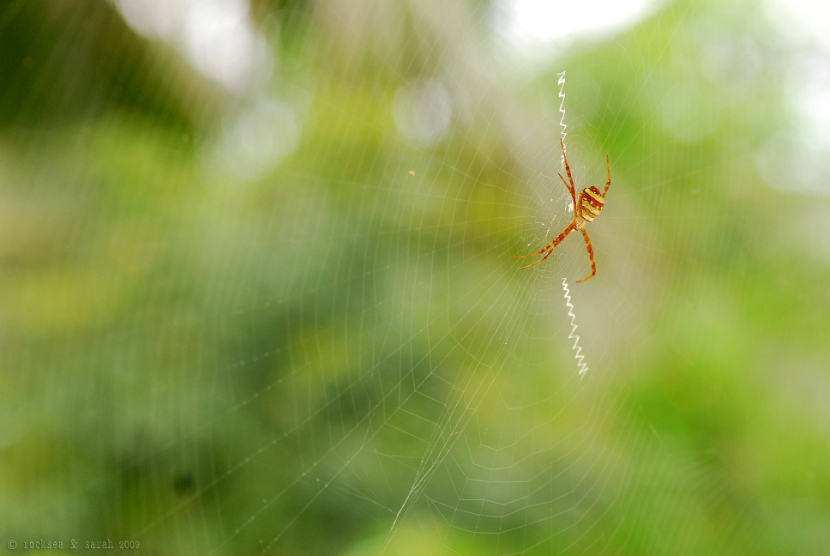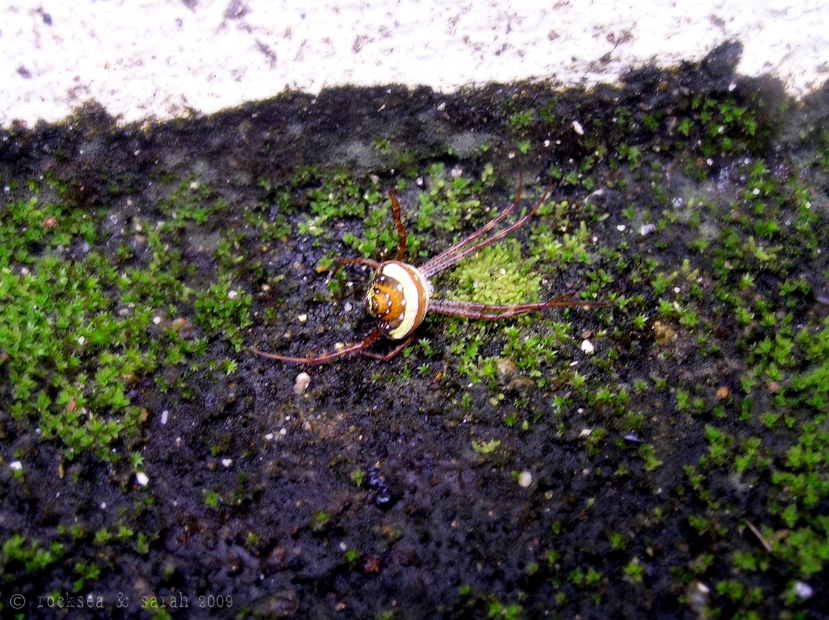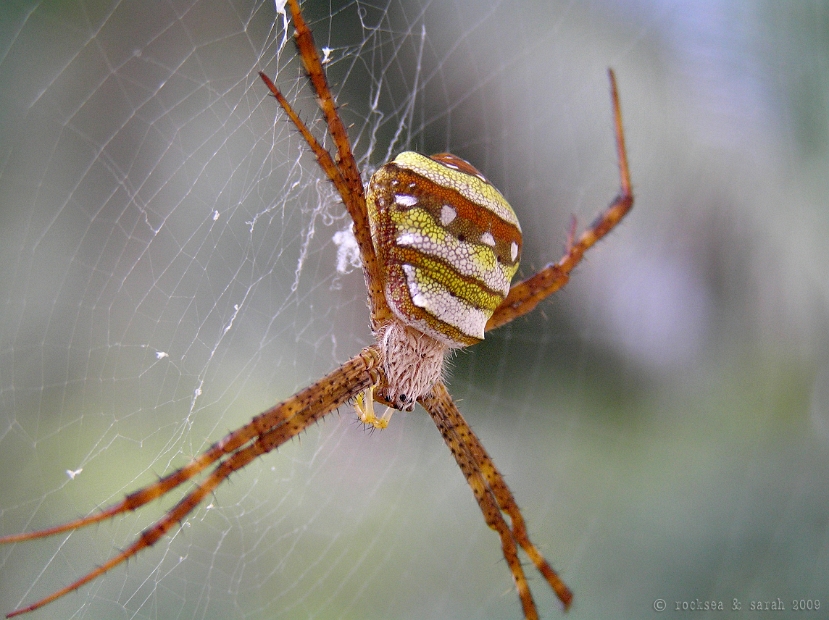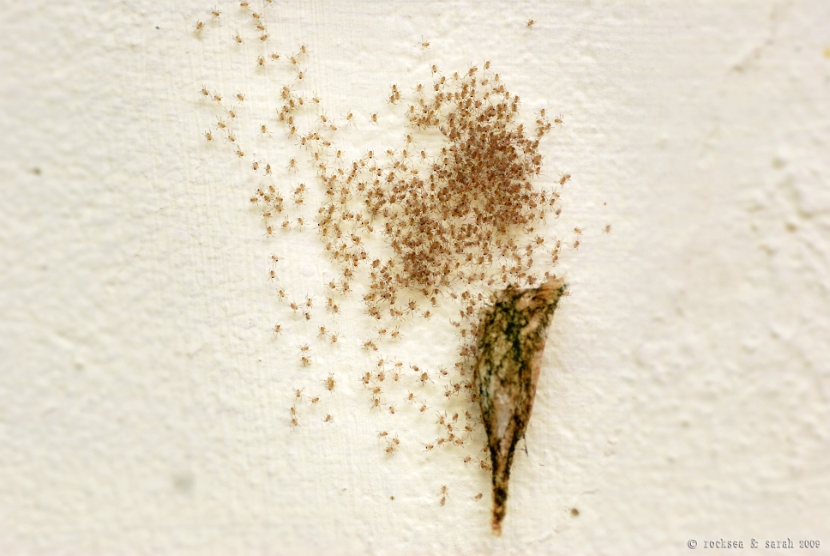spider X and st. andrew’s cross: death-feigning tactics
This is a common garden spider, but known by a lot of special names, one of them being the St. Andrew’s Cross spider. They are known so because they align their legs in the shape of an X, along the zig-zag patterns on the web. [St. Andrew is “said” to have martyred on such a cross, in the shape of an X, on his own request, as he felt himself unworthy to be crucified on the same way Christ was crucified].

They are known by different names in different places. In India, this particular species (species shown here: argiope anasuja), are known as “Signature Spiders” or “Speckled Band Fourlegs”. They are orb weaver spiders (Family: araniedae), which decorate their webs with stabilimenta. Stabilimenta is the zig-zag pattern which you see on the web, which serve different purposes like for stabilizing the web (and hence the name!), attracting prey, etc. The stabilimenta of juvenile orb weaver spiders are different, and more ornamental in hiding them [see argiope juvenile]. They usually rest in a head down position on the web. As one approaches the web, they hold their position until the last moment before slipping round in a flash to hide on the other side of the stabilimentum.
Sometimes, the stabilimenta is also in an X-shape (in the pictures here it is not a complete X), and the spider align each pair of its legs with the X, with its body in the centre.
The spider shown above is a female. Males are much smaller (3.5-4.5mm) compared to the females (8-12mm).
These are the spiderlings, just out of the egg! Could you count them up? I did a rough estimation, and it is between 500-600 spiderlings!

This happened while we were photographing the spiderlings above. Does this looks like we swatted it on to the ground?! No! The mother spider, all of a sudden, went shoo..shh… down the web, fell flat on the ground and stayed motionless, like it was suddenly drugged and died on the spot! The spider was actually feigning death, to divert our attention and to save the spiderlings! Later it simply walked away 🙂
Feigning death to divert the attention of the predator from its offsprings is practiced by several species. Such a death-feigning-tactic by the red whiskered bulbuls, of falling down and crawling on the ground making distress calls, was mentioned in a previous article.
Date: 16 Oct 2007
Location: @ home, Kottayam, Kerala, India
Camera: Nikon D80 + Tamron SP AF90mm f/2.8 Di Macro Lens & Olympus C770UZ + MCON-40 Macro Lens


 Roxy Mathew Koll is a Climate Scientist at the Indian Institute of Tropical Meteorology. He also dons the role of an amateur naturalist, writer, web designer, photographer, and publisher—based on demand.
Roxy Mathew Koll is a Climate Scientist at the Indian Institute of Tropical Meteorology. He also dons the role of an amateur naturalist, writer, web designer, photographer, and publisher—based on demand. Juby Aleyas Koll, also know as Sarah, is the author and publisher of the book and website Sarah’s Hand Embroidery Tutorials. She has been researching and tutoring hand embroidery for over a decade, making it accessible to everyone around the globe.
Juby Aleyas Koll, also know as Sarah, is the author and publisher of the book and website Sarah’s Hand Embroidery Tutorials. She has been researching and tutoring hand embroidery for over a decade, making it accessible to everyone around the globe.
today i spotted two St Andrews Cross Spiders in my veranda i was searching to see if it was poisonous, but thanks to this and many other sites i know they r not to humans, i was intrigued by the beautiful pattern it had created on its web,a beautiful ‘X’.
I wish I had seen this before I went hunting for clues to identify the argiope that I saw!
(http://madraswanderer.blogspot.com/2009/08/tree-guards-bagworms-and-argiopes.html)
Came her via the butterfly diaryist!
That last picture and explanation is amazing, as also the spiderlings!
Dear Flowergirl, am happy that you commented on our webspace that I got a chance to go through yours. Love your nature filled pages. It is amazing how we go on to explore similar aspects of life and wonder about them at same time. You posted your article on 20th and I talked abt the same spiders on 24th hehe. So at last you found out their names and they have indeed 8 legs! Yes the world outside have a lot more tricks and tactics and wonders to keep us amazed. Will keep crawling through your pages 🙂
just last week i saw a few of these on the well at naattile veedu, and was wondering what it was.. thanks for the story. and thanks for being our source of info on the small creatures that live around us.
Yes they are quite common in Kerala. Jaya, happy that these articles are sparking interest, and being informative 🙂
I guess it is only these small creatures that we have around in our daily life, at our hand’s reach – to amuse ourselves and our children on the myriad ways of life.
thanks andy, scorpio and elaine, for the comments 🙂
Interesting information and pictures of St. Andrew’s Cross spider. Did you estimate the number of spiderlings from the picture?
birdy, the number given is the estimation from the picture.
whoa!! too many spiders in that nest!! great macros!!
show me Spiderman.. I want to see Spiderman!! 🙂
Just loved this one! Great images! good natural history!
Yes ashiwn, I guess it is necessary for naturalists to move on from just identification of the species towards a better understanding of the ethology (behavioral science)!
Wow they are so colorful! Nice series.
Hey roxy, do these spiders bite?
Are they poisoneous…?
I guess, from what I read, that they are non-agressive and rarely bite. Even if they bite, it won’t be harmful than a mild pain.
Spiders will always be watched at a distance and with much fear 🙂
but was touched by the mother’s antic to save her kids.. never knew about it.. so much one does not know about nature…thanks for educating an ignorant nature lover 🙂
hey kittens, we were also surprised by its tricks. Yes, nature has a lot to teach us!!
I often marvel what a different view we get of some creatures when we focus our zoom lens on them! Thorough enjoyed the pictures.
Yes, as long as we don’t stop by and watch, we are much oblivious of the life happening around us!
I absolutely love to take photos of spiders and webs. Check out this post:
transientlives.blogspot.com/2008/11/ode-to-spider.html
I have been watching a couple of egg sacs for a year now and they haven’t hatched … great to see these hatchlings and the acting of the mother.
Bindu, thanks a lot for posting this link. I “feel” your spider story and could sense, to some extent, how you must have felt watching your spider, and how one day she left your world. It is the first time I am hearing such a long observational and intimate account on a spider. Keep watching!
We have the same spider families 🙂